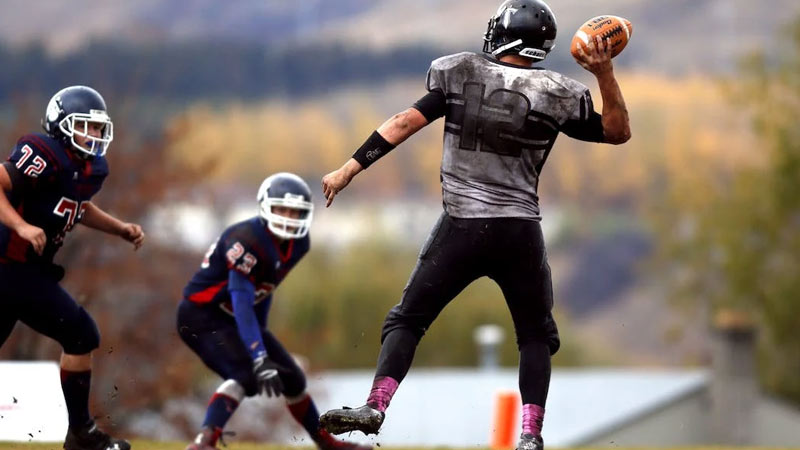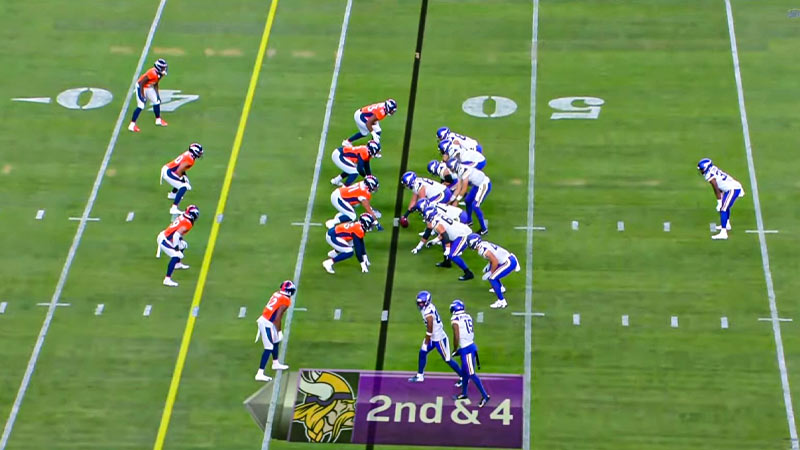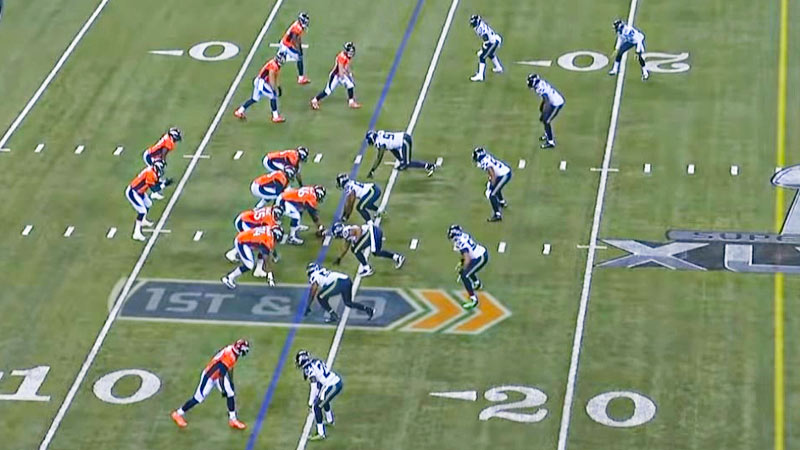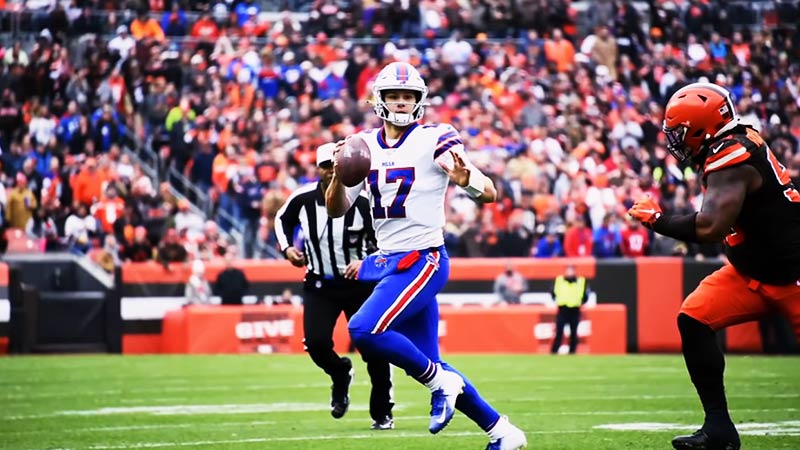In the world of American football, where split-second decisions and complex strategies rule the game, every movement on the field carries significance. One such intriguing gesture is the quarterback’s leg lift.
If you’ve ever watched a football game, you may have noticed that quarterbacks often raise one leg before the snap. It’s a seemingly subtle action, yet it plays a vital role in the orchestration of the offense.
But what does the leg lift signify, and why do quarterbacks lift their legs? Is it merely a matter of style, or does it serve a functional purpose?
In this exploration, we dive deep into the intricacies of the quarterback’s leg lift, unraveling the secrets behind this non-verbal language on the gridiron.
From its historical origins to its modern-day applications, we uncover the significance of this subtle yet essential aspect of quarterback play, shedding light on how it influences the rhythm and success of each offensive play.
Why Do Quarterbacks Lift Their Leg?

To understand why quarterbacks lift their legs, we must first delve into the historical roots of this practice.
In the early days of American football, long before the sport became the highly organized and televised spectacle it is today, communication on the field was rudimentary. Teams used various signals and cues to convey play calls and coordinate their movements.
One such signal was the quarterback’s leg lift. By raising a leg, the quarterback could indicate to the rest of the offense that they were ready to receive the snap and initiate the play.
This was particularly crucial in the days before helmets with communication systems and the sophisticated play-calling systems used today.
What’s the Modern Significance?
Fast forward to the present, and the quarterback’s leg lift still serves a vital purpose.
While modern technology has brought advances in communication, including helmet radios for quarterbacks and coaches relaying plays from the sidelines, the leg lift remains a fundamental part of the game. Here’s why:
Snap Timing
One of the primary functions of the quarterback’s leg lift is to signal to the center when to snap the ball. The leg lift initiates the silent count, helping to ensure that the snap and the quarterback’s drop-back are perfectly synchronized.
This precision in timing is essential for the success of the play, as any disruption in the snap count can lead to miscommunications, penalties, or turnovers.
Defensive Reads
The leg lift is also a tool that quarterbacks use to read the defense. Before the snap, quarterbacks survey the defensive formation and make decisions about the play based on what they see.
By initiating the snap count with a leg lift, they can observe how the defense reacts. If defenders shift or show their intentions too early, the quarterback may adjust the play accordingly, including changing the snap count or audibling to a different play altogether.
Cadence Variation
Quarterbacks often vary the timing and rhythm of their leg lifts and snap counts to keep the defense guessing. This variation can be a strategic advantage, as it can draw the defense offside or force them to reveal their intentions prematurely.
It also helps prevent the defense from timing their movements based on a predictable snap count.
False Starts

The leg lift serves as a built-in safeguard against false starts. Offensive linemen, receivers, and running backs must remain motionless until after the snap.
The quarterback’s leg lift provides a clear signal for the offense to move while keeping them stationary until that point. This helps minimize penalties due to players starting early.
Non-Verbal Communication
In a noisy stadium, with crowd noise reaching deafening levels, verbal communication can be challenging. The leg lift serves as a non-verbal means of communication that can be easily seen and understood by the entire offense, even in the midst of a cacophonous environment.
Play-Action and Deception
The leg lift is also instrumental in play-action and deception. When executing a play fake, the quarterback uses a leg lift to simulate the start of a passing play, even when intending to hand off the ball to a running back.
This element of surprise can keep the defense off balance and create opportunities for big gains.
Leadership and Control
Lastly, the leg lift is symbolic of the quarterback’s leadership and control over the offense. It conveys to the entire team that the quarterback is in charge, directing the flow of the game, and orchestrating the plays.
It’s a visual cue that signifies the quarterback’s authority and responsibility as the field general.
Variations and Styles
It’s worth noting that different quarterbacks have their own variations and styles when it comes to the leg lift. Some quarterbacks raise their leg only slightly, while others perform a more pronounced lift.
Some may incorporate a hitch in their lift to create additional variation in their snap count cadence. These individual nuances are often developed through years of practice and are tailored to a quarterback’s preferences and the needs of their team’s offensive system.
Can the Quarterback Move His Foot Before the Snap?

In American football, the rules governing a quarterback’s movement before the snap are specific and somewhat restrictive, designed to maintain the integrity of the game and ensure fair play.
While quarterbacks have limited movement options before the snap, there are certain actions they can take within the rules. Let’s delve into the details of what a quarterback can and cannot do with their feet before the snap.
Setting the Stance
Before the snap, the quarterback must start in a stationary position behind the line of scrimmage. This stationary position is commonly referred to as “under center” or “in the shotgun” depending on the offensive formation.
In either case, the quarterback’s feet should be set and stationary when they receive the snap from the center or the shotgun snap from the center or long snapper.
Adjusting the Stance
Once the quarterback has set their initial stance, they can make small adjustments to their foot positioning, but these adjustments are generally minimal.
For example, a quarterback might shift their weight slightly or make minor movements to better align themselves with the offensive formation or to accommodate the center’s snap.
Hard Count and Cadence
Quarterbacks have the ability to use their voice and body language to influence the defense before the snap. They can employ a “hard count” or cadence to try to draw defenders offside or to gather information about the defensive alignment.
The quarterback’s cadence typically includes phrases like “hut,” “set,” or “go,” and they may vary the rhythm and timing to keep the defense guessing.
Leg Movement
A quarterback’s leg movement before the snap is generally limited to subtle shifts or weight transfers.
They are not allowed to pick up their lead (forward) foot or simulate a snap by lifting their leg. Such actions would likely be considered a false start, which is a penalty that results in a loss of five yards for the offense.
Handling the Snap
Once the center or long snapper initiates the snap, the quarterback is allowed to move their feet to catch the snap or to begin their drop-back in preparation for the play.
The timing and execution of the snap and the quarterback’s movements are crucial for the play’s success.
Non-Verbal Signals
While not related to the quarterback’s feet, it’s important to note that quarterbacks often use non-verbal signals to communicate with their teammates and signal plays.
These signals can include hand signals, head nods, or eye movements, and they are an integral part of the quarterback’s pre-snap routine.
Defensive Movement Response
Quarterbacks are also allowed to react to the defensive movement before the snap. If they perceive a defensive shift or alignment that requires an adjustment, they can make pre-snap audibles, changing the play or snap count to exploit defensive weaknesses.
It’s worth emphasizing that the rules surrounding a quarterback’s pre-snap movement are in place to maintain fairness and prevent any advantage gained through deception or false starts.
A quarterback who moves their feet excessively simulates a snap, or engages in other actions that could be seen as attempts to deceive the defense may be penalized for a false start or encroachment if the defense reacts to these actions.
FAQs
Can a quarterback lift their leg before the snap as part of their cadence or hard count?
Yes, quarterbacks can use leg movement as part of their cadence or hard count to influence the defense and draw defenders offside. However, this movement is typically limited to subtle shifts or weight transfers rather than lifting the leg, which could be seen as a false start.
Are there any situations where a quarterback can move their foot before the snap without penalty?
Quarterbacks can make minor adjustments to their foot positioning before the snap, such as shifting their weight slightly to better align themselves with the offensive formation.
These adjustments are generally allowed as long as they don’t simulate a snap or deceive the defense.
What happens if a quarterback’s leg movement before the snap is deemed excessive or deceptive?
Excessive or deceptive leg movement by a quarterback before the snap can result in a penalty. The most common penalty for such actions is a false start, which results in a loss of five yards for the offense.
Do these rules apply to both the NFL and college football?
Yes, the rules regarding quarterback movement before the snap are generally consistent between the NFL and college football. Both levels of the sport have rules in place to prevent false starts and maintain fairness in the game.
Can quarterbacks use hand signals or verbal cues in their pre-snap communication with teammates?
Yes, quarterbacks often use hand signals, verbal cues, and non-verbal communication to convey play calls and adjustments to their teammates. These signals are an integral part of the quarterback’s pre-snap routine and are used to coordinate the offense effectively.
Conclusion
The quarterback’s leg lift, a seemingly small and subtle gesture, carries a world of significance in the game of American football.
As we’ve explored in this investigation, it’s far more than a mere stylistic choice; it serves as a crucial non-verbal language that quarterbacks use to communicate with their teammates and orchestrate the offense.
From its historical roots as a method of signaling plays to its modern-day applications in reading defenses and snap timing, the leg lift has evolved alongside the sport itself. It is a symbol of leadership, control, and precision on the field.
The quarterback’s leg lift embodies the essence of football’s complexity, where every movement and moment matters.
So, the next time you watch a football game and see the quarterback raise a leg, remember that it’s more than just a routine; it’s part of the intricate dance of football, where communication transcends words, and every play is a symphony of strategy and execution.







